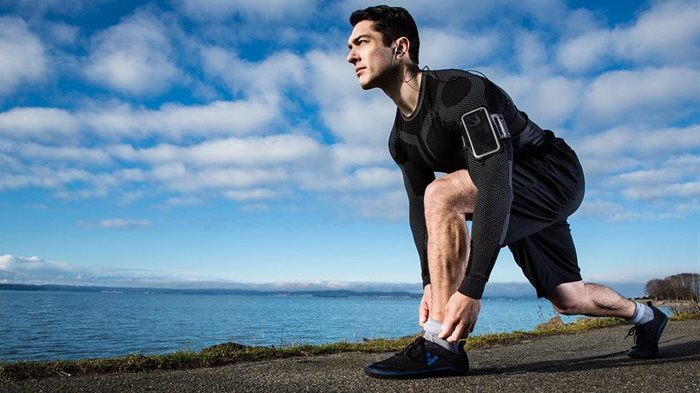
Imagine no more.
The integration of sensors into textiles and the development of conductive fabric creates the canvas for smart fabrics that can communicate with smartphones to process biometric information such as heart rate, temperature, breathing, stress, movement, acceleration, and even hormone levels.
Now smart fashion could potentially save lives. A firm favourite are sensory socks that evaluate neuro-visual processing dysfunction affecting balance and posture. It provides assessment and treatment, thereby reducing falls and injury.
Considering research that shows 2.5 million older people in the US alone are treated in emergency departments for fall injuries each year, this technology has far-reaching benefits particularly in assisting the elderly and those with balance problems.
“The wearable technology segment will be an important, if not the most important player in the medical smart textile market and account for large revenue share due to the increasing presence for remote patient monitoring,” says Davide Vigano, chief executive officer of Sensoria Health, who is working with Michael J. Fox and his foundation and integrating his technology into assisting patients with Parkinson's disease.
HUGE CONGRATS to Michael J. Fox and his foundation. We are honored to work with you and #NeuRa (Neuroscience Research Australia) at Sensoria Health Inc.https://t.co/jbqnLrjm1R#parkinsonsdisease #parkinsonsawareness #digitalhealth #michaeljfoxorg
— Sensoria Health (@SensoriaHealth) November 21, 2022
It is estimated that nearly one million people in the US are living with Parkinson's disease. This number is expected to rise to 1.2 million by 2030. Parkinson's is the second-most common neurodegenerative disease after Alzheimer's disease.
"The therapy and wellness segment will also drive revenue growth due to increasing incidents of acute and chronic illnesses, growing adoption of these smart textiles and the rising preference for remote patient monitoring (RPM)."
The landscape of wearable tech has changed dramatically with the convergence of conductive textiles and electronics.
"In 2013, wearables were not the same as they are today. Bulky and less than powerful - and not very accurate - most of them today remain limited to be positioned on the wrist," says Vigano. "The rest of the human body and the foot was especially under-served by technology and innovation."
Not so anymore. A recent review conducted by the University of A Coruña entitled IoT wearables and garments for creating intelligent connected e-textiles highlights how smart shirts are more natural to wear than a wristband or a chest strap, and are able to track more biometric signals due to the larger area of skin they cover.
There will be advances... and these will increasingly include energy harvesting: a method of converting body heat, movement, or solar energy into raw power providing advancements in longer battery life.
As a result, there are indicators that smart garments will be utilised in the near future on a much larger scale and could potentially leave traditional wearable technology, designed for wrists, in its dust.

The application of smart garments in remote patient monitoring is where this technology has incredible potential.
"Remote patient monitoring programmes is where we can expect to see huge growth in coming years," says Vigano.
"They have the potential to reduce both acute and chronic-care costs, hospital re-admissions and improve clinical outcomes by moving care out of the hospital or doctor’s office and into the home."
According to Health IT, the main benefits include:
Sensoria and PRT announced their collaboration to develop NeurOpTrek, the wearable solution for Risk of Fall (ROF) assessment to prevent and rehabilitate patients from fall injuries. Watch Dr. William Padula, OD demo "Most Innovative" AWARD WINNER ACRM | https://t.co/OkMWth3MCF
— Sensoria Health (@SensoriaHealth) November 18, 2022
“There is already a sizeable market filled with medical gadgets that track biometrics in real time. So, chances are that innovations will continue to improve how wearables monitor our health," says Vigano.
The Internet of Smart Clothing review explains that smart clothes that are able to monitor, document, augment and actuate on our lives will provide unprecedented opportunities for tackling global societal challenges in areas like smart and crowd-sourced health, ageing and work safety initiatives.
Far reaching, is that The Internet of Smart Clothing trendsetters will pave the way for a world where smart garments communicate with each other, with the objects in their environment and with remote servers on the internet in order to provide advanced services.
Nevertheless, in order for such applications to be successful, rising issues of incompatibility with different types of electronic systems and smart textiles will need to be resolved, and the awareness of the benefits of smart textiles increased in underdeveloped countries, Vigano says.
The next generation of wearables, fabrics and garments also needs to be flexible and fashionable, providing efficient power management, carrying out high-performance computing tasks and making use of energy-harvesting devices.
"The future of wearable technology will include successes and failures," warns Vigano. "Wearable tech will probably follow the same minimalist trend that cellphones took when they started ramping up.
"There will be advances in biometric identification and authentication and these will increasingly include energy harvesting: a method of converting body heat, movement, or solar energy into raw power providing advancements in longer battery life.
“The future is ever-changing and some predictions might seem funny or irrelevant in a few years, but it’s safe to say that wearable technology is and will continue to be a popular and viable solution for a wide range of applications.”